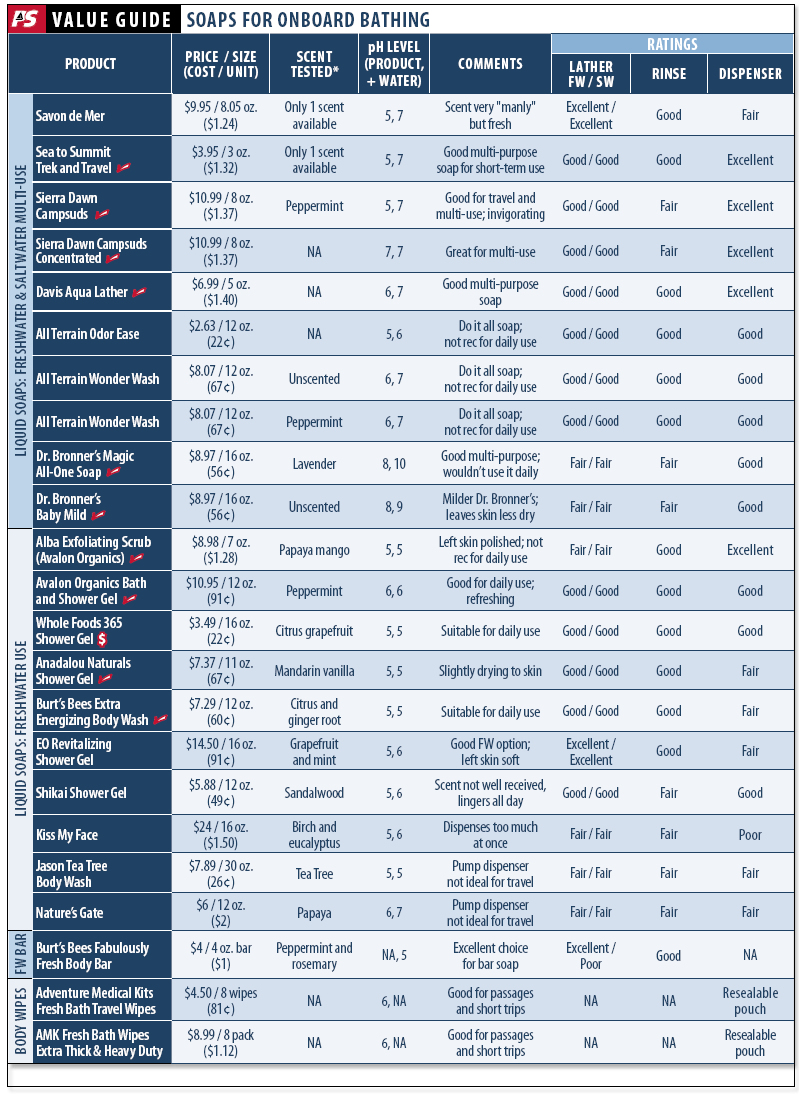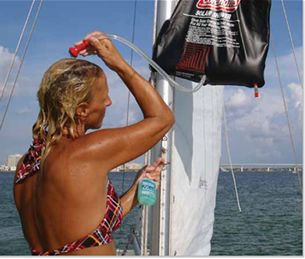
305
Practical Sailor often gets reader letters asking about the best methods and products for keeping the crew clean onboard. Maintaining personal hygiene on a sailboat raises unique challenges over shore showering. On long passages or extended off-the-beaten-path trips when fresh water is tightly rationed, sailors need products that rinse off with little water, are effective in salt water, or require no water at all. On boats with cockpit showers, eco-friendly soaps are a must so that harmful chemicals aren’t being washed directly overboard. And some dockside live-aboards require phosphate-free products to meet their marina’s evolving environmental standards.
With thousands of products on the market dedicated to keeping us clean, Practical Sailor out to find the best ones that meet sailors’ specific onboard personal hygiene needs. We narrowed the field by focusing on biodegradable products, since soaps used onboard are not likely to be filtered through a municipal water treatment system before they enter the marine environment. Testers compared 22 body washes, shower gels, bar soaps, and body wipes—barely a drop in the bucket of what’s available, but the test products do represent a good cross-section of those that are widely available from box stores, grocery stores, health food stores, and marine chandleries.
What We Tested
Practical Sailor testers chose products for this test based on what the soaps didn’t have. We looked for products that were biodegradable and phosphate free. (Similar to fertilizers, phosphates can cause a rapid growth of algae when washed into the water supply.)
We also sought products without phthalates and parabens, which have been associated with health risks. Phthalates, usually listed in product ingredients as “Fragrance,” are banned in Europe but not in the U.S. In many products, the chemically derived gelling agents have taken the place of castor oil and camphor oil, plant-based oils originally used in soaps to soften skin.
Another common debate in the soap product safety world is the widespread use of sodium laurel sulfate (SLS) and sodium laureth sulfate (SLES). Both are widely used in soaps and shampoos to enhance lathering ability. Many of our selected test products, marketed as “natural” contain SLS and SLES. Most of the products we tested that are marketed for saltwater use contain SLES and other sulfates, which enable the products to lather in salt water.
After sweating and wetting, lathering and rinsing, diving, and repeating all steps several times with 20-plus products, testers found very little difference in the products’ ability to clean. (For details on the test protocol, see “How We Tested. “) Sweaty bodies, dirty hands, smelly feet, greasy fingers, oily hair, and saltwater-encrusted skin all got clean. After a final and familiarly-successful rinse, testers decided to dive in for a deeper look at the way soaps clean and what might make a particular soap a better choice for specific types of sailors. The accompanying Value Guide summarizes our findings and identifies testers’ Recommended products.
SOAP 101
Soaps are surfactants, or surface active agents, that lower the surface tension of a liquid, the tension between two liquids, or the tension between a liquid and a solid. When soap compounds reduce the usually strong attraction between two water molecules, they make it easier for water to soak into pores or clothes—whatever’s being washed. Soap molecules are long and thin with two distinct, polar ends. The head of a soap molecule is attracted to water and will attach to it, while the molecule’s tail is attracted to oil. The soap doesn’t dissolve oil like a solvent; it attaches to oil with its tail end, and the oil is flushed away with the water attached to the molecule’s head end.
One of the most common pitfalls in choosing a soap or shampoo is selecting the product based on fragrance or lathering qualities. Although lathering is what consumers most often associate with a superior product, the ingredients that create lather are not the ingredients that do the cleaning, degreasing, or deodorizing. For example, Castile soaps produce fewer bubbles and foam, but they are excellent cleaning agents.
Soaps are manufactured by mixing an oil (either an animal fat or a plant oil) to an alkaline material, often lye or sodium hydroxide. Plant oils commonly used to make soaps are olive oil, sunflower oil, hemp oil, palm kernel oil, canola oil, almond oil, and castor oil. Coconut, palm, shea, and cocoa butters are solid oils commonly used.
Each oil adds specific properties to a soap. Olive oil provides mildness, while coconut and palm kernel oils provide textural hardness and lathering. Castor oil is a humectant, a substance that helps a formula retain water. Camphor oil can be used as a lubricant or a softener. Mass-produced soaps most commonly use a mixture of tallow (a substance made from rendered beef or pork fat, mixed with palm and coconut oils).
A note on Castile Soaps
Castile soaps, first produced in Spain’s Castile region in the mid-13th century, were vegetable-based soaps made from the area’s local olive oil. Today, “Castile soap” is used to describe any vegetable-based soap. They are generally at least 40-percent olive oil, but may also contain coconut, hemp, palm, avocado, almond, and walnut oils.
Olive-oil soaps have a large amount of natural glycerin and can seem slippery instead of foamy like the more mass-produced, commercial soaps. Palm and coconut oils can be added to make olive oil soaps less slippery.
Castile soaps are gentle on hair and skin and are good for those who have sensitive skin. They are more environmentally friendly than soaps with chemically achieved lather, and can be used to shave, shampoo, wash clothes, scrub floors, and bathe pets. Their multi-purpose cleaning abilities make Castile soaps ideal candidates for onboard use.
We will be testing the Castile soaps we review in this report (the Dr. Bronner’s formulas) and other multi-purpose soaps that rated highly in this test in our followup look at onboard laundry products.
Saltwater Soaps
Ten of the test products are made for use in both fresh and salt water: Savon de Mer Fresh and Salt Water Shampoo and Body Gel; Campsuds Bath Soap and Shampoo Peppermint; Concentrated Campsuds; All Natural’s Wonder Wash Fragrance Free; Wonder Wash Peppermint; and Wonder Wash Odor Ease; Davis’ Aqua Lather; Sea to Summit Trek and Travel Body Wash Concentrated; Dr. Bronner’s Magic Soap Pure-Castile Soap; and Dr. Bronner’s Baby Mild.
Testers found that neither of the Dr. Bronner’s products produced a thick lather in salt water, but neither soap creates large, sudsy bubbles in fresh water either. As a pure Castile soap with no lathering agents added, the olive-oil based Dr. Bronner’s have a large amount of natural glycerin. Diluting the soap before use can make it easier to rinse off and won’t affect its cleaning ability.
The other eight saltwater/freshwater products lathered well in both environments, but all eight contain sulfates. Savon de Mer, both Campsuds products, Trek and Travel Body Wash, and Aqua Lather include SLES, while the three Wonder Wash products use sodium coco sulfate, a coconut derivative that’s generally held as safer and less irritating than SLES.
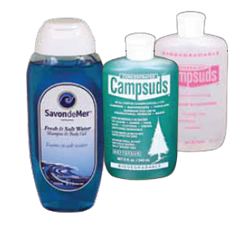
247
We found that several of the products would be well suited for travel and multi-use options. While all of the products could be used as a soap and/or shampoo, the Campsuds, Wonder Wash, Dr. Bronner’s, and Trek and Travel products suggest additional multi-uses such as laundry and dishwashing. Campsuds are highly concentrated, and the 8 ounces of slow dispensing liquid would last a long time, especially if it’s diluted before use. (Testers found the concentrates easier to rinse when they were diluted.)
Savon de Mer was popular for its rich, bubbly lather but opinions on its scent ran the gamut. Several testers found that Dr. Bronner’s Magic Soap dried out their skin, but the company’s Baby Mild was less drying; testers attributed the difference to the fact that the baby formula contains more olive oil.
In our opinion, the multi-use products would serve quite well as shampoo-soaps for short cruises, passages, and short-term, but testers felt most of the products were too strong for everyday use, particularly on the hair.
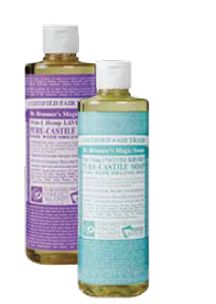
216
The Dr. Bronner’s products and the All Terrain products all cost less than $1 per ounce, while the other test products in this niche—from $1.32 to $1.40 per ounce—were among the most expensive in the line up.
Bottom line: Savon de Mer was popular with male testers, but female testers found the smell too strong. Its second ingredient after water is SLES, and its price was near the top of our product field, per ounce. Dr. Bronner’s soaps are available in numerous scents, sizes, and formulas, and its price is one of the lowest in the field. While we wouldn’t use it seven days a week as a shampoo, and users would have to embrace life without bubbles, the olive oil-based Castile soaps have been around for more than 60 years. It contains no sulfates, rated well across the board, and gets our recommendation as a saltwater or multi-use soap.
General Liquid Soaps
Ten of the remaining products we tested had no SLS or SLES, although other sulfates and milder chemical alternatives were present in some of the products: Alba Papaya and Mango Exfoliating Shower Gel; Andalou Naturals Shower Gel; Avalon Organics Bath and Shower Gel; Burt’s Bees Body Wash ; Kiss My Face Active Athlete Bath and Shower Gel; EO Revitalizing Shower Gel; Nature’s Gate Body Wash; Jason Tea Tree Pure Natural Body Wash; Shikai All Natural Shower Gel; and 365 Shower Gel.
These all lathered, rinsed, and cleaned in fresh water and salt water, although none are marketed as saltwater soaps. The products with a higher percentage of oil and with fewer lathering agents produced less lather and felt slick during use. A few “curdled” in the saltwater rinse, but all came clean in the fresh water.
Testers liked the Alba Exfoliating Body Wash and Avalon Organics Bath and Shower Gel, which are both made by Avalon Organics. Alba’s gentle exfoliants were soothing and removed sweat, dirt, and odors, but it would not be suitable as a shampoo or for laundry or dishwashing. Also, some testers said they wouldn’t use it daily because it’s an exfoliant and took more water than other soaps to rinse off bodies and bath cloths. Note that if you are in the sun a lot—which most sailors are—exfoliating can make your skin more susceptible to the sun. Testers all liked the papaya-mango fragrance and the feel of their skin after washing with Alba. Priced at $1.28 per ounce, it was at the high end of the price range. Avalon Bath and Shower Gel had across-the-board Good ratings and was priced at 91 cents per ounce.
The remaining products were all found to have Fair to Excellent lathering properties; views on fragrance varied widely, with different testers describing the same product as “Too sickly sweet” and “Yummy.” Peppermint and Lavender seemed to be the most universally appealing scents. At 22 cents per ounce, the 365 Everyday Body Wash (Whole Foods’ store brand) had a good price point for an eco-friendly soap. The Andalou and Burt’s Bees soaps also received good reviews and were well-priced at 67 cents per ounce and 60 cents per ounce, respectively.
Bottom line: All of the testers gave Alba high marks, although not for everyday use; it gets our recommendation for an exfoliating soap. Avalon Organics, Andalou, and Burt’s Bees earned PS’s recommendation for freshwater liquid soaps that can be used daily. The 365 Everyday’s lower cost makes it highly appealing for long-term use; it earned the PS Budget Buy pick.
Bar Soaps
The main difference between liquid and bar soap is that liquid soaps use the plant-based potassium hydroxide to convert oils to soaps, while sodium hydroxide is used to make the hard bar soaps.
We tested Burt’s Bees Fabulously Fresh Peppermint and Rosemary Body Bar. Testers all liked the scent, the lathering qualities, and the strong sense of clean the soap bar left. Although bar soaps last longer than body gels, they can be messier, and all testers felt liquid soap was a better choice for onboard use. This choice would be subjective to how clean you like your onboard shower, and, without delving into the too-much-information arena, your soap bar.
Bottom line: Testers prefer liquid soaps to bar soaps for onboard bathing, but the Burt’s Bees did earn high marks and didn’t dry our skin like most common bar soaps such as Dial.
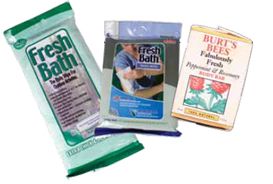
273
Body Wipes
We tested Adventure Medical Kits Fresh Bath Body Wipes, both the Travel Wipes and the larger Extra Thick & Heavy Duty. We found both to be excellent for weekend trips, post-race freshening up, boat camping, or an any-time wipedown. The alcohol-free wipes clear sweat, salt, dirt, and odors from skin without leaving the skin feeling clammy, greasy or overly dry. The antibacterial wipes contain aloe vera and vitamins A and E to help moisturize skin; their mild formulas mean they are safe for all skin types, and our testers even used them on their faces.
Testers enjoyed the packages’ instructions, which list, in sequential order, the body parts to be cleaned: face, neck, chest; right arm, left arm, perineum, right leg, left leg, back, buttocks. There’s no mention of the feet.
Testers found that a quick wipedown with the AMK wipes was refreshing, and they unanimously preferred them over run-of-the-mill body wipes and baby wipes from companies like Huggies. However, the AMK wipes’ high price—essentially $1 per wipe, or “shower”—was a bit much to swallow.
Bottom line: Fresh Bath Body Wipes would be good to have onboard to supplement regular washing and for those times when fresh water is too precious to use for bathing. They’d be particularly handy for wiping off the salt before climbing into your bunk after a night watch, when showering is unlikely an option—salt-crusted skin can lead to rashes and salt-crusted sheets can lead to an always-soggy berth.
Conclusion
There are tons of soaps, shower gels, and shampoos available that lather, clean, and rinse well in both fresh and salt water. Joy Dishwashing Liquid, Ivory Soap, and Johnson Baby Shampoo are regularly recommended, along with other products, on cruising forums and websites. Although these products might work in salt water, they contain phosphates or other ingredients that don’t meet our test criteria for water-quality- and body-friendly bathing products.
Multi-purpose soaps with puncture-proof containers and spill-proof dispensers are a good choice for short cruises. The Campsuds, Trek and Travel, and Aqua Lather products are all solid choices for short-term use for hair and body, particularly when saltwater showers are likely. We would not recommend these for everyday, long-term use.
Dr. Bronner’s Magic liquid Castile soap labels list 18 ways to use them, including bathing, shampooing, dishwashing, and laundry. Although some testers said they would moisturize after using it or would opt for Dr. Bronner’s Baby Mild formula, Dr. Bronner’s liquid soap could be used long-term for a multitude of tasks in fresh water and salt water. If you need a bodywash-shampoo, go for the Baby Mild formula.
For a single-use, everyday liquid soap, testers’ top picks from this field were Avalon Organics, Burt’s Bees, Andalou, and 365 Everyday. Testers also liked the non-greasy, alcohol free Travel Wipes, but we’d likely opt for a similar product that’s less expensive, like the alcohol-free Seventh Generation Baby Wipes ($14 for 350 wipes, www.seventhgeneration.com), which contain only plant-derived ingredients.
If you’re interested in learning more about what’s in personal cleaners—and why you should be concerned about some ingredients—check out two resources we’ve found valuable: the nonprofit Environmental Working Group’s website, www.ewg.org, and Livestrong, www.livestrong.com. Both sites, in addition to manufacturers’ websites, are good go-to sources for more information on soaps.
